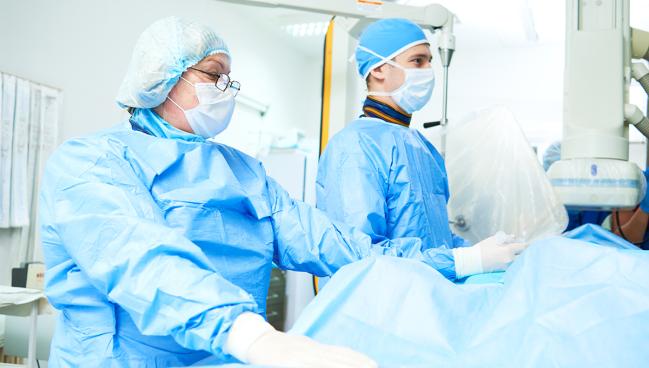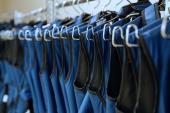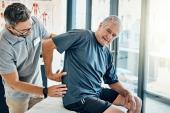Orthopedic and Radiation Injuries Unchanged in Cath Lab Staff Since 2014
A SCAI survey found high rates of spinal injury amid signs that careers could be longer with better prevention and management.

Despite increased attention and improved technologies for radiation mitigation over the last decade, cardiac cath lab staff are still dealing with an unacceptably high level of occupational hazards to their physical health, a new survey shows.
The results, gathered by the Society for Cardiovascular Angiography and Interventions (SCAI), were published yesterday in the organization’s journal JSCAI.
Since SCAI’s last survey, in 2014, there has been “a disturbing lack of progress,” with no declines in rates of orthopedic injuries or cancer diagnoses, say Islam Abudayyeh, MD (VA Loma Linda Healthcare System, CA), and colleagues.
“If you look at any other career, there are protections in place that people are required to use whether it slows them down or not. If you’re a construction worker, you have to wear the hard hat, you wear the safety harness, because there are rules in place,” he said. “We don’t have those rules in interventional cardiology.”
Part of the struggle to encourage interventional cardiology staff to protect themselves stems from ingrained actions, often left over from training, that give them permission to prioritize workflow over safety, he said.
“I think that's a false narrative because quite frankly you can have safety and efficient workflow. It's not a zero-sum issue,” Abudayyeh said. “But it can be very difficult to untrain from your ingrained habits.”
Same Numbers, Different Decade
The Occupational Health Hazards in Interventional Cardiology 2023 survey consisted of 29 items. The questions inquired about the number and type of procedures performed annually, absences from work for illness or injury, the use of protective equipment and garments, expected age of retirement, wearing of radiation badges, institutional safety programs, and radiation culture in the workplace. Overall, the questions replicated the 2014 SCAI occupational health hazards survey as much as possible.
A total of 296 individuals (17% women; 61% age 30-50 years old) completed the online survey between May and August 2023. The cohort consisted of 91% interventional cardiologists, 7% fellows-in-training, and 2% interventional echocardiographers or invasive noninterventional cardiologists. Approximately 40% had been in practice for between 5 and 15 years, and the majority were in practice in the United States. The median annual procedural caseload was 602, with coronary procedures being the most common type.
Only 18% of respondents reported no injuries resulting from cath lab work. More than 65% said they had experienced musculoskeletal pain related to wearing lead or working in the cath lab, and 60% reported at least one orthopedic injury. Approximately 20% reported injuries to the hip/knee/ankle or wrist/elbow/shoulder. One third reported lumbar spine injuries, while 25% reported cervical spine injuries.
Approximately 6% reported having cancer and 5% reported having cataracts or skin injury. Respondents reported being aware of even more injuries and illnesses among staff and colleagues: 25% knew of a someone who’d developed cataracts, 11% had heard of an acquaintance having a brain tumor, and 15% were aware of some other type of cancer.
Limiting or reducing the number of procedures performed due to an orthopedic problem affected nearly one in five respondents. Approximately 20% reported needing to take a leave of absence for a physical or mental occupational hazard or injury.
The mean annual number of coronary procedures increased from 400 to 500 (P = 0.002) and structural procedures from 20 to 50 (P = 0.023) when compared with the 2014 survey, but 17% of respondents limited their hours in the cath lab either by personal choice or because their institution required them to do so to cut down on their radiation exposure.
Higher annual caseloads were significantly associated with wrist/elbow/shoulder injuries (P = 0.03) and any orthopedic injury (P = 0.04).
Compared with those aged 30-40, those who were aged 51-70 had greater risk of orthopedic injury (adjusted OR 2.28; 95% CI 1.09-4.80 and adjusted OR 3.93; 95% CI 1.67-9.27, respectively).
The survey also found that more than one-quarter of women reported being discouraged from working in the cath lab due to pregnancy or future pregnancy considerations and 71% wanted the option to step away from cath lab duties during a pregnancy.
It can be very difficult to untrain from your ingrained habits. Islam Abudayyeh
To TCTMD, Abudayyeh noted that more than 80% of those who took the survey said they would probably work more years in the cardiac cath lab if injuries were better prevented or managed. One in five said they would likely extend their careers by 10 years or more.
“Cervical spine and lumbar injuries are extremely costly to institutions, especially when you have to replace highly trained people such as interventionalists and structural imagers for a month or more,” he said.
The amount of money a hospital loses as a result of procedures that need to be rescheduled is more than sufficient to pay for expensive newer technologies that let operators work without the demands of wearing lead, he added. In a recent global survey of interventional cardiologists, less than 2% reported having access to more sophisticated equipment like robotic PCI or the zero-gravity Rampart (Rampart ic) portable radiation shielding systems.
For hospital administrators, Abudayyeh said the allocation of funds for this type of equipment to keep staff safe in the cath lab has been shown to help both with retention and with recruitment.
“You can't fix a problem until you recognize it. We recognize the problem, and we need to be looking at advocacy in terms of shifting the paradigm away from wearable to nonwearable protection to start protecting our backs, protecting ourselves, and switching over to low radiation systems,” he added.
L.A. McKeown is a Senior Medical Journalist for TCTMD, the Section Editor of CV Team Forum, and Senior Medical…
Read Full BioSources
Abudayyeh I, Dupont AG, Hermiller JB, et al. Occupational health hazards in the cardiac catheterization laboratory: results of the 2023 SCAI survey. JSCAI. 2025;Epub ahead of print.
Disclosures
- Abudayyeh reports serving as a member of the California Department of Public Health’s Radiologic Technologist Certification Committee.





Comments